Tour Information
| Travel |
Tour Information
|
Seoul Tour Information
Transport Information of major tour spots
- For more information, please tab the button.
6001: Namdaemoon Market, Myeong-dong Station, Toegye-ro 3Ga(Han-ok Village), DDP
6002: Sinchon Hyundae department, Seoul Museum of History (Gyeonghui Palace), Heongin ji moon
6006: COEX Mall. Samseong station, Jamsilsaenae Station
6705: Jamsil Lotte World Hotel
Lotte World(Jamsil)

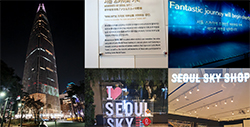

- Lotte World(Theme park and Lotte World Folk Museum)
- Lotte World Tower(Seoul Sky and Aquarium)
- Seokchon Lake
- Lotte World Tower is one of Korea's architectural crown jewels. The tower symbolizes the meeting of the modern with the traditional, nature and cutting edge technology, and the accomplishments of man. Lotte World Tower contains everything that is necessary for modern urban living.
- Soaring 555m into the air; with 123 stories, Lotte World Tower is home to Korea's tallest observation deck, (at 500m) Seoul Sky. Korea's newest luxury landmark hotel, Signiel Seoul is also located at Lotte World Tower. Also located in the tower is Podium, a multi-floor, multipurpose space where visitors will find a healthcare center, a fitness center, and a financial center.
- The Lotte World Mall, a global fashion hub, also calls Lotte World Tower home, and visitors will also be able to shop at Korea's largest urban duty free store, Lotte Duty Free. Other features include the shopping mall Avenuel, Korea's best urban aquarium, a spectacular classical music hall, and Asia's largest multiplex. Experience the best of modern living in Seoul at the Lotte World Tower!
- Location: 05551 300, Olympic-ro (Sincheon-dong), Songpa-gu, Seoul
- Homepage: https://www.lwt.co.kr/en/main/main.do
- Transportation: Subway Lines 2 & 8, Jamsil Station, Exits 2 & 11 (5 mins on foot)
Jongno Area

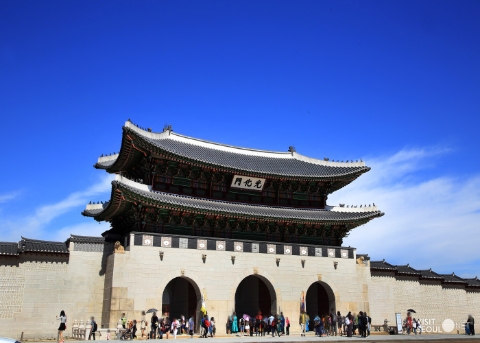
- Gyeongbokgung Palace
- Changgyeonggung Palace
- Jongno has been a commercial center since old times. It is a representative area in Seoul where you can see both tradition and modernity. It is where palaces like Gyeongbokgung Palace and Jongmyo are located, along with modern high-rise buildings and shopping districts.
- Gyeongbokgung Palace was the first and largest of the royal palaces built during the Joseon Dynasty. Built in 1395, Gyeongbokgung Palace was located at the heart of the newly appointed capital of Seoul (then known as Hanyang) and represented the sovereignty of the Joseon Dynasty. The largest of the Five Grand Palaces (the others being Gyeonghuigung Palace, Deoksugung Palace, Changgyeonggung Palace, Changdeokgung Palace), Gyeongbokgung served as the main palace of the Joseon Dynasty.
- The Korean government has invested much time and effort into rebuilding, restoring, and maintaining the palace for future generations. These efforts include work to rebuild and restore the buildings that were destroyed during the Japanese occupation. Visitors to Gyeongbokgung can also visit the National Palace Museum of Korea and the National Folk Museum of Korea as they are located on the palace grounds.
- To increase ease of accessibility from Gyeongbokgung Palace to Seochon and vice versa, the palace's western gate, Yeongchumun, was opened to the public on December 2018. For the past 43 years, there were only 3 entrances to Gyeongbokgung Palace - the southern gate Gwanghwamun, the northern gate Sinmumun, and the eastern entrance of National folk Museum of Korea. However, with the opening of the western gate Yeongchumun, entry to the palace from all directions has been now made possible.
- Location:161. Sajik-ro, Jongno-gu, Seoul, 03045, Republic of Korea
- Website: https://www.royalpalace.go.kr:8443/html/eng_gbg/main/main.jsp
- Transportation:
o Subway Line 3, Gyeongbokgung Station, Exit 5 (5 mins on foot)
o Subway Line 5, Gwanghwamun Station, Exit 2 (10 mins on foot)
Jongno Area
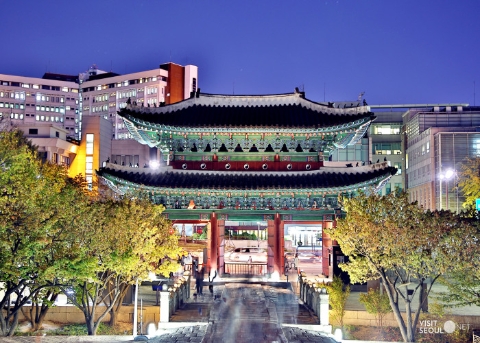
- Anguk Station Hanok Village
- Gyeongbokgung Palace
- Changgyeonggung Palace
- Changgyeonggung Palace was built in 1483 by King Seongjong (the ninth king of the Joseon Dynasty) to take care of the wives of the preceding kings. Compared to other palaces, the size of the palace is compact and simple. Changgyeonggung Palaceis connected with Changdeokgung Palace. It's located east of the primary palace of Gyeongbokgung, so it is also referred to as "Donggwol," the "East Palace."
- Myeongjeongjeon is the main hall of the palace, where state affairs were held, such as meetings with officials and the reception of foreign envoys. In particular, Myeongjeongjeon represents an outstanding example of seventeenth century Joseon architectural style and is the oldest main hall of any palace. While visiting Changgyeonggung Palace, it is recommended you visit nearby Changdeokgung Palace as well.
- Most of the palace buildings were destroyed by the Japanese during the Japanese invasion of Korea in 1592. The main buildings such as Myeongjeongjeon, Munjeongjeon (council hall), Hwangyeongjeon (Hall), Inyangjeon (Hall), Gongsacheong, and Honghwamun (Gate) were rebuilt by King Gwanghaegun (the fifteenth king of the Joseon Dynasty). During the Japanese occupation, the Japanese built a zoo on the site and renamed the palace "Changgyeongwon," meaning "Changgyeong Garden." Since 1987, the palace has been reconstructed and now resembles its original form.
- Location: 03072 185, Changgyeonggung-ro, Jongno-gu, Seoul
- Website: https://english.cha.go.kr/html/HtmlPage.do?pg=/royal/RoyalPalaces_3.jsp&mn=EN_02_03_04
- Transportation: Subway Line 4, Hyehwa Station, Exit 4 (15 minutes by foot)
Coex Mall
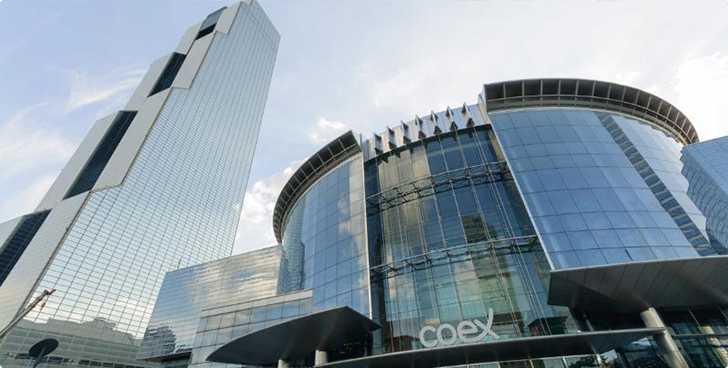

- Coex Mall
- Starfield Library
- COEX Mall is a super-large underground shopping mall with over 260 shopping stores, a super-large library, an aquarium, a department store, and a movie theater.
- Located in the center of COEX Mall, Starfield Library is an open public space where anyone can freely come to sit down, take a break, and immerse themselves in books along with other bibliophiles. A wide selection of books in various genres such as humanities, economics, hobbies, etc. are readily available. Whole sections of the library are dedicated to foreign books and famous authors. iPads can be used to read e-books. Close to 600 magazines, domestic and foreign, are available for browsing. All these qualities set Starfield Library apart from other ordinary libraries. In addition, a plethora of events take place here such as meeting with authors, book talks, poetry reading, lectures, book concerts, and more.
- Location: 06164 513, Yeongdong-daero, Gangnam-gu, Seoul
- Transportation:
o Subway Line 2, Samseong Station, Exits 5 & 6
o Subway Line 9, Bongeunsa Station, Exits 1/6/7
o Subway Line 7, Cheongdam Station, Exit 2
Deoksugung Palace and Jeong-dong


- Lotte World(Theme park and Lotte World Folk Museum)
- Lotte World Tower(Seoul Sky and Aquarium)
- Seokchon Lake
- Deoksugung Palace was originally called Gyeongungung Palace. After succeeding to the throne from King Gojong, King Sunjong renamed the palace as Deoksugung in hope of King Gojong's healthy and long life when he moved to Changdeokgung Palace. In the palace, visitors can learn about the history of the late Joseon Dynasty and the Korean Empire and see the traditions and the modern times of Korea.
- The Royal Guard-Changing Ceremony is held everyday in front of Deoksugung Palace Daehanmun Gate. Tourists often stop here and watch the ceremony. The coexistence of Korean traditional and western-style architectural characteristics of Deoksugung Palace create a unique atmosphere that attracts many onlookers. The palace looks peaceful, but it is actually a living testament of the turbulent period of the Korean Empire.
- After looking around Deoksugung Palace, walk down Deoksugung Stone Wall Path, known for being a street of romance. You can learn more about modern history in this place. Feel and experience the traces of the Korean Empire throughout Jeong-dong.
- Location : 99, Sejong-daero, Jung-gu, Seoul (Jeong-dong)
- Homepage : http://www.deoksugung.go.kr
Namsan Park & N Seoul Tower

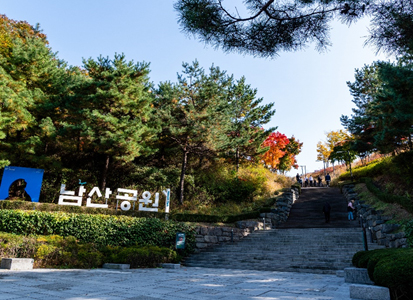
- N Seoul Tower, considered as being one of the symbols of Seoul along with Namsan Park, is loved by many citizens for being a tourist attraction and a resting place. Namsan Park, which was constructed with Namsan Mountain as the center, is the largest park in Seoul. The park is divided into Jangchung District, Yejang District, Hoehyeon District, and Hannam District. The park features trails, outdoor stages, N Seoul Tower, and other various facilities to enable restful and cultural activities of Seoul citizens.
- Namsan Park that witnessed a long history of Seoul is home to the recreational interests of numerous citizens. The Seoul City Wall starts from the back street of Jangchung Gymnasium and numerous statues and monuments, including Baekbeom Plaza and the Statue of Ahn Jung-geun, can be found standing here. Among the beauty of Namsan Mountain, our ancestors enjoyed nature and arts. Namsangol Hanok Village, one of the must-see attractions for Korean and foreign tourists, was restored at the northern foot of Namsan Mountain. In Namsangol Hanok Village, you can peacefully enjoy beautiful nature just like how our ancestors enjoyed nature and arts.
- Location
o Namsan Park : 231, Samil-daero, Jung-gu, Seoul
o N Seoul Tower – N Seoul Tower, 105, Namsangongwon-gil, Yongsan-gu, Seoul - Homepage
o Namsan Park : https://parks.seoul.go.kr/template/sub/namsan.do
o N Seoul Tower : http://www.nseoultower.com
Seoul City Wall
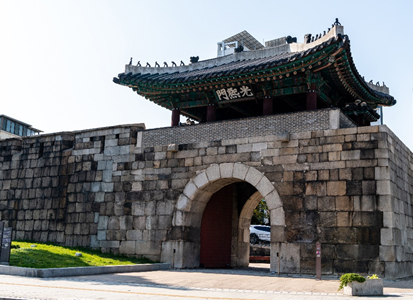

- King Taejo of the Joseon Dynasty built Seoul City Wall to protect the city of Seoul against invaders. The wall stretches approximately 18.2km and its area encompasses 467,922㎡. The wall has the four great gates (Heunginjimun Gate of the east, Donuimun Gate of the west, Sungnyemun Gate of the south, and Sukjeongmun Gate of the north) and the four small gates (Honghwamun Gate of the northeast, Gwanghuimun Gate of the southeast, Changuimun Gate of the northwest, and Sodeongmun Gate of the southwest). During King Sejong the Great and King Sukjong's reign, refurbishment efforts were carried out on the wall. Construction period and methods can be identified by the stone bricks of different shapes.
- Take a look at the shapes of stone bricks. You may think that all stone bricks have the same shape, but they don't. They have different shapes and are made of different materials. The time of construction can be divided into three: King Taejo who first constructed Seoul City Wall, King Sejong, and King Sukjong. During King Taejo's reign, rough and natural stone bricks were mainly used and small stones were inserted between stone bricks. In King Sejo's refurbishment efforts, properly sized stones were chiseled. Big stone bricks were laid at the bottom and small stone bricks were situated at the top. Roughly 300 years later, King Sukjong carried out five-year refurbishment efforts. During this work, stone bricks were chiseled into a rectangular shape to allow for substantial structures. Therefore, the time of construction can be estimated on the basis of the shapes of stone bricks.
- Location
o Gwanghuimun Gate : 105, Gwanghui-dong 2-ga, Jung-gu, Seoul
o Sungnyemun Gate : Sungnyemun Gate, 40, Sejong-daero, Jung-gu, Seoul - Homepage : http://seoulcitywall.seoul.go.kr/
Namsangol Hanok Village

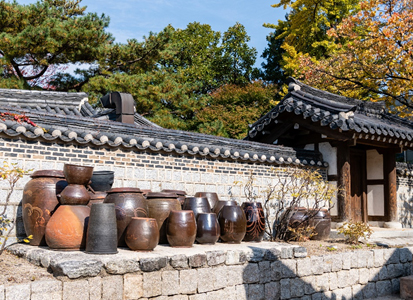
- Namsan Hanok Village opened on April 18, 1998 and was constructed to be a part of the Namsan Restoration Project in 1989. Namsan Hanok Village was developed on the site of the Capital Defense Command, consisting of 5 hanok houses designated as folklore resources by the Seoul Metropolitan Government, as well as a Traditional Craft Museum, Cheonugak Pavilion, Traditional Garden, Seoul Namsan Traditional Theater, and New Millennium Time Capsule Plaza.
- Namsan Mountain has been famous for centuries for its beautiful landscapes and had been visited by many vacationing aristocrats. Sitting on the pavilion and listening to the sound of water and wind in Namsan Hanok Village, you can feel the arts that were loved by our ancestors. In Hanok Village, situated at the northern foot of Namsan Mountain, experience the beauty of hanok and enjoy traditional culture of Korea.
- Location : 28, Toegye-ro 34-gil, Jung-gu, Seoul
- Homepage : https://www.hanokmaeul.or.kr/
Seoul Plaza

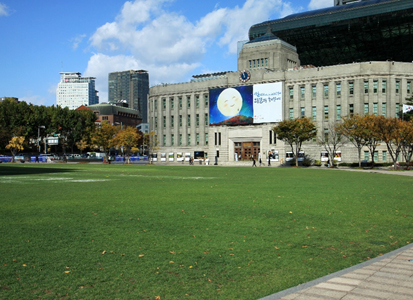
- On May 1, 2004, Seoul Plaza opened in front of Seoul City Hall. The total area of Seoul Plaza occupies 3,995-pyeong and about half of the area, amounting to 1,904-pyeong, is the grass square. Seoul Plaza is perfectly situated near tourist attractions. Cheonggyecheon Stream, Jeong-dong, and Seoul Museum of Art are only 10 minutes' walk from Seoul Plaza.
- Seoul Plaza is an iconic gathering place for Seoul citizens. Anyone can kick back and relax and take in the free atmosphere at Seoul Plaza. Until Seoul Plaza was reconstructed as a plaza in 2004, it was a road filled with cars. Seoul Plaza, however, became the symbol of Culture Station Seoul and a place for citizens.
- Location : 110, Sejong-daero, Jung-gu, Seoul
- Homepage : http://plaza.seoul.go.kr/
Namdaemun Market

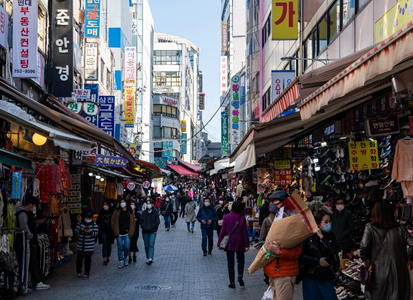
- Namdaemun Market is Korea's iconic market featuring 1,700 items and a wide range of food to choose from. Daily visitors to the market tend to roughly average 400,000 and the market is now a must-see attraction for foreign tourists.
- Namdaemun Market was named as such because it was located next to Namdaemun Gate (Sungnyemun Gate), the first National Treasure of South Korea. Namdaemun Market was formerly known as Chilpae Market which first opened in the 18th century and had become a commercial center of Seoul. Since then, Namdaemun Market has been witness to joys and sorrows of Korea’s modern history.
- Location : 21, Namdaemunsijang 4-gil, Jung-gu, Seoul
- Homepage : http://namdaemunmarket.co.kr/
For more travel information, Please refer to below useful sites.
COPYRIGHT © 2020 JUUNGGU-OFFICE ALL RIGHT RESERVED.
 Korea Tourism Organization
Korea Tourism Organization Seoul Metropolitan Government
Seoul Metropolitan Government Juunggu-Official Website
Juunggu-Official Website